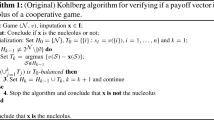Abstract
In this article we derive a class of cooperative games with non-transferable utility from multiple objective linear programs. This is done in order to introduce the nucleolus, a solution concept from cooperative game theory, as a solution to multiple objective linear problems.
We show that the nucleolus of such a game is a singleton, which is characterized by inclusion in the least core and the reduced game property. Furthermore the nucleolus satisfies efficiency, anonymity and strategic equivalence.
We also present a polynomially bounded algorithm for computation of the nucleolus. Letn be the number of objective functions. The nucleolus is obtained by solving at most2n linear programs. Initially the ideal point is computed by solvingn linear programs. Then a sequence of at mostn linear programs is solved, and the nucleolus is obtained as the unique solution of the last program.
Similar content being viewed by others
References
Banker RD (1980) A game theoretic approach to measuring efficiency. European Journal of Operational Research 5:262–268
Banker RD, Charnes A, Cooper WW, Clarke R (1989) Constrained game formulations and interpretations for data envelopment analysis. European Journal of Operational Research 40:299–308
Belenson SM, Kapur KC (1974) An algorithm for solving multicriterion linear programming problems with examples. Operational Research Quarterly 24:65–77
Bergstresser K, Yu PL (1977) Domination structures and multicriteria problems inn-person games. Theory and Decision 8:5–48
Blackwell D (1956) An analog of the minimax theorem for vector payoffs. Pacific Journal of Mathematics 6:1–8
Christensen F (1991) On the nucleolus of general cooperative games. Discussion Paper 91-01. Institute of Economics, University of Copenhagen, Denmark
Forgó F (1984) A game-theoretic approach for multicriteria decision making. In: Grauer M, Wierzbicki AP (eds) Lecture notes in economics and mathematical systems 229, Springer-Verlag Berlin Heidelberg New York 41–46
Gale D, Kuhn HW, Tucker AW (1951) Linear programming and the theory of games. In: Koopmans TC (ed) Activity analysis of production and allocation. John Wiley & Sons 317–329
Kalai E (1975) Excess functions for cooperative games without sidepayments. SIAM Journal on Applied Mathematics 29:60–71
Karmarkar N (1984) A new polynomial-time algorithm for linear programming. Combinatorica 4:373–395
Kopelowitz A (1967) Computation of the kernels of simple games and the nucleolus of n-person games. Research Program in Game Theory and Mathematical Economics. Research Memorandum No 31, Department of Mathematics, The Hebrew University of Jerusalem, Israel
Maschler M, Peleg B, Shapley LS (1979) Geometric properties of the kernel, nucleolus, and related solution concepts. Mathematics of Operations Research 4:303–338
Maschler M, Potters JAM, Tijs SH (1992) The general nucleolus and the reduced game property. International Journal of Game Theory 21:85–106
Schmeidler D (1969) The nucleolus of a characteristic function game. SIAM Journal of Applied Mathematics 17:1163–1170
Sobolev AI (1975) The characterization of optimality principles in cooperative games by functional equations. In: Vorobjev NN (ed) Matematicheskie Metody v Sotsial'nykh Naukakh. Proceedings of the Seminar. Institute of Physics and Mathematics, Academy of Sciences of the Lithuanian SSR, Vilnius 94–151 (In Russian, English Summary)
Steuer RE (1986) Multiple criteria optimization: Theory, computation, and application. John Wiley & Sons
Zeleny M (1975) Games with multiple payoffs. International Journal of Game Theory 4:179–191
Author information
Authors and Affiliations
Additional information
Financial support from Nordic Academy for Advanced Study (NorFA) is gratefully acknowledged. Part of this work was done during autumn 1993 at Institute of Finance and Management Science, Norwegian School of Economics and Business Administration.
Rights and permissions
About this article
Cite this article
Christensen, F., Lind, M. & Tind, J. On the nucleolus of NTU-games defined by multiple objective linear programs. Mathematical Methods of Operations Research 43, 337–352 (1996). https://doi.org/10.1007/BF01194552
Received:
Revised:
Issue Date:
DOI: https://doi.org/10.1007/BF01194552




